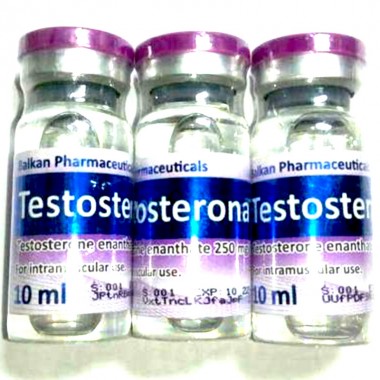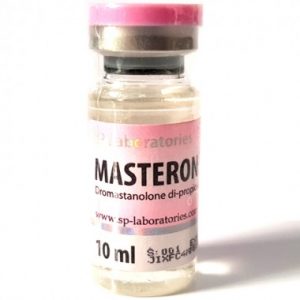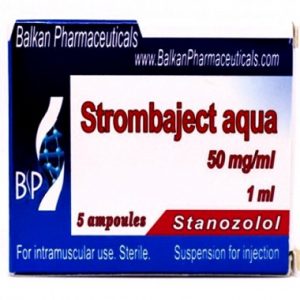Description
DESCRIPTION OF THE PREPARATION: Transparent oily solution, from light yellow to yellow, with a characteristic odor. Dosage form Oily solution for injections. PHARMACOTHERAPEUTIC GROUP and ATC code: Androgenic hormone, G03B A03. PHARMACOLOGICAL PROPERTIES: Pharmacodynamic properties Testosterone enanthate is an ester of testosterone. Testosterone is the primary male sex hormone synthesized and secreted by the testicles. It stimulates the growth and development of male reproductive organs and secondary sexual characteristics (maturation of the prostate, seminal vesicles, penis and scrotum), distribution of male pattern hair on the face, pubis, chest), development of the larynx, body muscles and distribution of fat. Retains nitrogen, sodium, potassium and phosphorus, enhances anabolism and reduces protein catabolism. Premature increase in plasma testosterone concentration in the period before puberty causes closure of the epiphyses and growth arrest. Stimulates the production of erythropoietin and red blood cells. By the mechanism of negative feedback (feedback) inhibits the secretion of luteinizing and follicle-stimulating hormones of the pituitary gland and inhibits spermatogenesis. In men with primary hypergonadotropic hypogonadism, normalization of the level of gonadotropins is noted. In women, it inhibits the gonadotropic function of the pituitary gland, the function of the ovaries, mammary glands, and causes atrophy of the endometrium. Antagonistic action against estrogens is used in the treatment of fibroids, endometriosis, breast cancer. It has a beneficial effect on complaints of menopause. Pharmacokinetic properties: Testosterone enanthate is absorbed slowly.The maximum concentration in the blood is observed 72 hours after administration. The action lasts 2-4 weeks. In the blood, almost 98% of testosterone binds to a specific fraction of globulins that binds testosterone and estradiol. Biotransformation occurs in the liver to various 17-ketosteroids, which, after conjugation with glucuronic or sulfuric acid, are excreted in the urine (approximately 90%). About 6% of the absorbed drug is excreted in the feces in an unbound form. INDICATIONS: In men – hormone replacement therapy for disorders associated with testosterone deficiency:
- delayed puberty,
- eunuchoidism, underdevelopment of the genital organs,
- endocrine impotence,
- hypopituitarism,
- symptoms of male menopause (decreased libido, mental and physical activity),
- post-castration syndrome (androgen deficiency after castration),
- osteoporosis due to androgen deficiency.
Among women:
- hyperestrogenism, functional bleeding,
- uterine fibroids,
- endometriosis,
- menopause (in combination with estrogens),
- mammary cancer,
- osteoporosis.
METHOD OF APPLICATION AND DOSES: Intramuscularly, deep into the gluteal muscle. The dosage regimen is selected individually, depending on the disease, sex, age, clinical effect. As a rule, adults are administered intramuscularly 50-200 mg every 2-4 weeks. It is not recommended to exceed the dose of 400 mg per month. The duration of treatment is set individually. For hypogonadism in men as eunuchoidism, the recommended doses are 50-400 mg every 2-4 weeks. With a delay in puberty, 50-200 mg is used every 2-4 weeks for 4-6 months. For breast cancer in women: 200-400 mg every 2-4 weeks. The drug must not be administered intravenously! SIDE EFFECTS:
- Priapism and other signs of excessive sexual stimulation (frequent erections),
- in boys in the prepubertal period – accelerated sexual development, increased frequency of erections, enlargement of the penis and premature closure of the epiphyses,
- damage to spermatogenesis and impaired maturation of spermatozoa, oligospermia and a decrease in ejaculate volume,
- prostate anomalies,
- in women – bleeding from the birth canal, increased libido, with prolonged use of the drug, virilization symptoms are possible,
- hirsutism, gynecomastia,
- seborrhea, acne, oily skin, accelerated hair loss,
- sodium and water retention, edema,
- symptoms of hypercalcemia,
- thrombophlebitis,
- nausea, cholestatic jaundice, increased levels of liver aminotransferases (as they stop taking, they normalize),
- headache, depression, aggressiveness, anxiety, sleep disturbance, paresthesia.
- Pain, itching and hyperemia at the injection site are possible.
CONTRAINDICATIONS: increased individual sensitivity to the components of the drug, prostate or breast carcinoma, prostatic hypertrophy with symptoms of urination disorders, nephrosis or nephrotic phase of nephritis, edema, hypercalcemia, impaired liver function, diabetes mellitus, heart and coronary insufficiency, a history of myocardial infarction, atherosclerosis in older men, pregnancy, breastfeeding. OVERDOSE: In acute overdose, testosterone toxicity is extremely low. In chronic overdose, priapism may develop. In this case, treatment should be stopped, and after the disappearance of symptoms – start in smaller doses.PRECAUTIONS AND PECULIARITIES OF APPLICATION: In the event of androgen-dependent adverse reactions, testosterone treatment should be discontinued. After the disappearance of side effects, resume treatment at lower doses. Patients with latent or severe heart failure, impaired renal function, hypertension, epilepsy or migraine (or a history of these conditions) should be monitored constantly, since androgens can in some cases cause sodium and water retention. With prolonged use, check liver function. In patients with breast cancer, hypernephroma, lung cancer with bone metastases, check the level of calcium in the blood and urine. In prepubertal boys, androgens should be used with caution to avoid premature closure of the epiphyses and accelerated sexual development. INTERACTION WITH OTHER DRUGS: Increases the effectiveness of anticoagulants and hypoglycemic agents (you need to change doses), inhibits the excretion of cyclosporine. Liver enzyme inducers (barbiturates, rifampicin, carbamazepine, phenylbutazone, phenytoin) reduce the effect of testosterone. STORAGE CONDITIONS: Store at a temperature of 15-25°C, in a dry, dark place and out of the reach of children. EXPIRY DATE: 5 years. Do not use after the expiry date stated on the package. NAME AND ADDRESS of the manufacturer: SC Balkan Pharmaceuticals SRL st. Gradescu, 4 Chisinau, Republic of Moldova PRODUCT DESCRIPTION: Transparent oily solution, from light yellow to yellow, with a characteristic odor. Dosage form Oily solution for injections. PHARMACOTHERAPEUTIC GROUP and ATC code: Androgenic hormone, G03B A03.PHARMACOLOGICAL PROPERTIES: Pharmacodynamic properties Testosterone enanthate is an ester of testosterone. Testosterone is the primary male sex hormone synthesized and secreted by the testicles. It stimulates the growth and development of male reproductive organs and secondary sexual characteristics (maturation of the prostate, seminal vesicles, penis and scrotum), distribution of male pattern hair on the face, pubis, chest), development of the larynx, body muscles and distribution of fat. Retains nitrogen, sodium, potassium and phosphorus, enhances anabolism and reduces protein catabolism. Premature increase in plasma testosterone concentration in the period before puberty causes closure of the epiphyses and growth arrest. Stimulates the production of erythropoietin and red blood cells. By the mechanism of negative feedback (feedback) inhibits the secretion of luteinizing and follicle-stimulating hormones of the pituitary gland and inhibits spermatogenesis. In men with primary hypergonadotropic hypogonadism, normalization of the level of gonadotropins is noted. In women, it inhibits the gonadotropic function of the pituitary gland, the function of the ovaries, mammary glands, and causes atrophy of the endometrium. Antagonistic action against estrogens is used in the treatment of fibroids, endometriosis, breast cancer. It has a beneficial effect on complaints of menopause. Pharmacokinetic properties: Testosterone enanthate is absorbed slowly. The maximum concentration in the blood is observed 72 hours after administration. The action lasts 2-4 weeks. In the blood, almost 98% of testosterone binds to a specific fraction of globulins that binds testosterone and estradiol. Biotransformation occurs in the liver to various 17-ketosteroids, which, after conjugation with glucuronic or sulfuric acid, are excreted in the urine (approximately 90%). About 6% of the absorbed drug is excreted in the feces in an unbound form. INDICATIONS: In men – hormone replacement therapy for disorders associated with testosterone deficiency:
- delayed puberty,
- eunuchoidism, underdevelopment of the genital organs,
- endocrine impotence,
- hypopituitarism,
- symptoms of male menopause (decreased libido, mental and physical activity),
- post-castration syndrome (androgen deficiency after castration),
- osteoporosis due to androgen deficiency.
Among women:
- hyperestrogenism, functional bleeding,
- uterine fibroids,
- endometriosis,
- menopause (in combination with estrogens),
- mammary cancer,
- osteoporosis.
METHOD OF APPLICATION AND DOSES: Intramuscularly, deep into the gluteal muscle. The dosage regimen is selected individually, depending on the disease, sex, age, clinical effect. As a rule, adults are administered intramuscularly 50-200 mg every 2-4 weeks. It is not recommended to exceed the dose of 400 mg per month. The duration of treatment is set individually. For hypogonadism in men as eunuchoidism, the recommended doses are 50-400 mg every 2-4 weeks. With a delay in puberty, 50-200 mg is used every 2-4 weeks for 4-6 months. For breast cancer in women: 200-400 mg every 2-4 weeks. The drug must not be administered intravenously! SIDE EFFECTS:
- Priapism and other signs of excessive sexual stimulation (frequent erections),
- in boys in the prepubertal period – accelerated sexual development, increased frequency of erections, enlargement of the penis and premature closure of the epiphyses,
- damage to spermatogenesis and impaired maturation of spermatozoa, oligospermia and a decrease in ejaculate volume,
- prostate anomalies,
- in women – bleeding from the birth canal, increased libido, with prolonged use of the drug, virilization symptoms are possible,
- hirsutism, gynecomastia,
- seborrhea, acne, oily skin, accelerated hair loss,
- sodium and water retention, edema,
- symptoms of hypercalcemia,
- thrombophlebitis,
- nausea, cholestatic jaundice, increased levels of liver aminotransferases (as they stop taking, they normalize),
- headache, depression, aggressiveness, anxiety, sleep disturbance, paresthesia.
- Pain, itching and hyperemia at the injection site are possible.
CONTRAINDICATIONS: increased individual sensitivity to the components of the drug, prostate or breast carcinoma, prostatic hypertrophy with symptoms of urination disorders, nephrosis or nephrotic phase of nephritis, edema, hypercalcemia, impaired liver function, diabetes mellitus, heart and coronary insufficiency, a history of myocardial infarction, atherosclerosis in older men, pregnancy, breastfeeding. OVERDOSE: In acute overdose, testosterone toxicity is extremely low. In chronic overdose, priapism may develop. In this case, treatment should be stopped, and after the disappearance of symptoms – start in smaller doses. PRECAUTIONS AND PECULIARITIES OF APPLICATION: In the event of androgen-dependent adverse reactions, testosterone treatment should be discontinued.After the disappearance of side effects, resume treatment at lower doses. Patients with latent or severe heart failure, impaired renal function, hypertension, epilepsy or migraine (or a history of these conditions) should be monitored constantly, since androgens can in some cases cause sodium and water retention. With prolonged use, check liver function. In patients with breast cancer, hypernephroma, lung cancer with bone metastases, check the level of calcium in the blood and urine. In prepubertal boys, androgens should be used with caution to avoid premature closure of the epiphyses and accelerated sexual development. INTERACTION WITH OTHER DRUGS: Increases the effectiveness of anticoagulants and hypoglycemic agents (you need to change doses), inhibits the excretion of cyclosporine. Liver enzyme inducers (barbiturates, rifampicin, carbamazepine, phenylbutazone, phenytoin) reduce the effect of testosterone. STORAGE CONDITIONS: Store at a temperature of 15-25°C, in a dry, dark place and out of the reach of children. EXPIRY DATE: 5 years. Do not use after the expiry date stated on the package. NAME AND ADDRESS of the manufacturer: SC Balkan Pharmaceuticals SRL st. Gradescu, 4 Chisinau, Republic of Moldova





Reviews
There are no reviews yet.